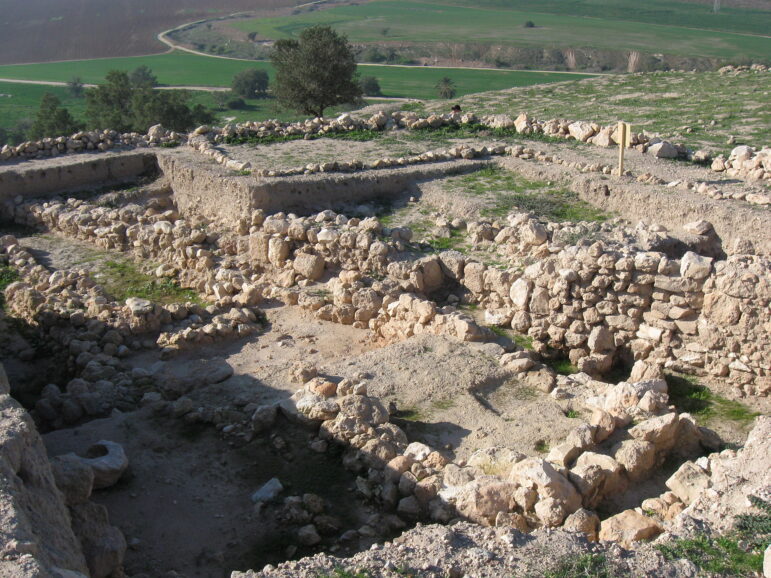JERUSALEM – A team of researchers from Israel’s Bar-Ilan University announced the unearthing of botanical remnants and archaeological clues at a 3,000-year-old temple situated in central Israel. These findings are crucial in unraveling the mysteries surrounding the ancient people of south Canaan, commonly referred to as the Philistines. The researchers said that the evidence suggests a Mother Goddess cult, as well as the use of plant medicines that included psychoactive substances.
The research published recently in Scientific Reports describes the excavation of two successive temples at Tell eṣ-Ṣâfī/Gath, Tel Tsafit, an archaeological site located in central Israel. It is identified as the largest known Philistine settlement and is recognized as the ancient city of Gath. The site has been particularly interesting to archaeologists and historians because of its association with the Philistines, an ancient people mentioned in biblical accounts and known for their interactions and conflicts with the Israelites. Gath is mentioned in the Bible as the home of Goliath, ‘a champion out of the camp of the Philistines, whose height was six cubits and a span’ (Samuel 17:4), and famously felled by David.

David and Goliath by Michelangelo, on the Sistine Chapel ceiling (1509). [Public Domain
The site has previously provided valuable insights into the material culture, daily life, and religious practices of the Philistines during the Iron Age. Discoveries at Tell eṣ-Ṣâfī have included artifacts, structures, and remains that contribute to our understanding of the ancient history and dynamics of the region. The site is significant not only for its historical and biblical associations but also for the information it provides about the broader cultural context of the ancient Near East.
In the present investigation, archaeologists aimed to enhance our understanding of these ancient communities. They relied, in part, on charred seeds and fruits retrieved from the remnants of an ancient temple in Gath, covering two consecutive periods of its usage between the ninth and tenth centuries B.C.E. The ancient city of Gath/Tell eṣ-Ṣâfī is located about halfway between Jerusalem and the modern city of Ashkelon on the Mediterranean coast.
The focus on plants has helped the researchers describe not only their possible use but also how the site connected across the cultures of the regions. The researchers write that “plants in ritual contexts shed light on the seasonality of rites, the role of agriculture, medical/psychoactive activities, and the geographic origin of offerings.”
The researchers noted that the site links up many aspects of ritual practice and how the Philistines could tap elemental powers. Some plants appear to be used for incense, others as insecticides, and still others for medicine and magic.
“Freshwater, agriculture, and the cyclical birth, death, and rebirth of a plant are recognized and venerated as transformative, and even magical, in the oldest myths, such as the Gilgamesh epic, the tale of Aqhat, and the worship of deities such as Tammuz, Ishtar, and Baal.”
The researchers also noted that “These widespread Mediterranean plants were known so far only in later cults,” the authors of the new study write, which they link to “early Greek deities, such as Hera, Artemis, Demeter, and Asclepios.” The plants also appear to highlight cross-cultic connections in regional traditions and practices.
The research team highlighted the chaste tree as an example. Although the chaste tree is widespread around the Mediterranean, its symbolic use is limited to ancient Greece. The plant is associated with cults in Sparta (Artemis and Asclepios), with Thesmophoria rites, as well as with the cult of Hera on Samos.

Archaeological findings at Tell es-Safi [Photo Credit Ori~
The archaeological team also found evidence of psychoactive plant use as part of the rituals performed at Gath/Tell eṣ-Ṣâfī. One plant, poison darnel (commonly called ryegrass), is a natural source of ergot, a fungus that “contains an LSD-type alkaloid, known to be hallucinogenic, used by midwives and as a fortifying ingredient in brewing.”
Ergot is known in other contexts related to the more recent Witch Trials of the 1600s. Some historians believe that an ergot infestation in Massachusetts caused strange activities among some women in 1691 and eventually led to the Salem witch hunts. Toxicologists now know that ergot poisoning can lead to convulsions, spasms, hallucinations, crawling sensations on the skin, and erratic behaviors.
The researchers noted the ergot’s “use in cultic contexts as a psychoactive is mentioned in relation to the Greek Eleusinian Mysteries, associated with cults of agriculture.” They added, “It is plausible that temple ritual praxis included the use of medicinal and mood-enhancing additions to regular foods.” The presence of ritual chalices suggests the use of these substances in this manner.
What seems clear is that the site had ritual use connected with season and offerings while also being a place of healing and connection to mother goddesses across the region. The findings also appear to show that the practices of using these plants were older than their presence in later cults of early Greek deities, such as Hera, Artemis, Demeter, and Asclepios.
“These female deities accord with the wide occurrence of female figurines in Philistine contexts,” the researchers wrote, adding that the discovery of figurines at Gath/Tell eṣ-Ṣâfī “connect Philistines with widespread cults of the Aegean or Mycenaean Great Mother Goddess.”
The researchers underscored that the Philistine religion clearly relied on the “magic and power of nature, such as freshwater and seasonality, which influence human life, health, and activity.”
The Wild Hunt is not responsible for links to external content.
To join a conversation on this post:
Visit our The Wild Hunt subreddit! Point your favorite browser to https://www.reddit.com/r/The_Wild_Hunt_News/, then click “JOIN”. Make sure to click the bell, too, to be notified of new articles posted to our subreddit.